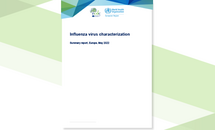Influenza virus characterization - Summary Europe, November 2022
The October 2022 characterisation report, was the first report for the 2022-2023 influenza season. As of week 48/2022, 24 737 detections had been reported. Of these detections, 93% were type A viruses, with A(H3N2) dominating (64%) over A(H1N1)pdm09 (36%), and 13% type B of which 321 were ascribed to a lineage, with all being B/Victoria. This represents a 6-fold increase in detections compared to the 2021- 2022 season, despite only a modest increase (2%) in the number of samples tested. The epidemic threshold of 10% positivity within sentinel specimens was crossed in week 45/2022 and increased to 20% in week 48/2022.
Executive Summary
Seven shipments from countries within the WHO European Region were received at the London WHO Collaborating Centre, the Francis Crick Worldwide Influenza Centre (WIC) since the October report. This report focuses on viruses with collection dates after 31 August 2022 for which HA gene sequences were submitted to, and released in, the EpiFlu database of the Global Initiative on Sharing All Influenza Data (GISAID) in November 2022, together with sequences and antigenic data generated at the WIC.
Globally, the great majority of the A(H1N1)pdm09 viruses detected in the first nine weeks of the 2022-2023 season have fallen in the HA 6B.1A.5a.2 subgroup. As a percentage of type A viruses detected in the WHO European Region there has been an increase to 36% from 4% in the same period in 2021. Clear antigenic discrimination of 6B.1A.5a.1 and 6B.1A.5a.2 viruses has been shown in many previous reports. While circulating 6B.1A.5a.2 viruses are well recognised by post-infection ferret antisera raised against A/Victoria/2570/2019-like viruses, being used in vaccines for the northern hemisphere 2022-2023 influenza season, they are recognised less well by post-vaccination sera from humans. Recently circulating 6B.1A.5a.2 viruses carry HA1 K54Q, A186T, Q189E, E224A, R259K and K308R amino acid substitutions compared to A/Victoria/2570/2019 so the recommendation was to change the vaccine component to an A/Sydney/5/2021-like virus (carrying these substitutions) for the southern hemisphere 2023 season. A(H1N1)pdm09 viruses continue to diversify and viruses with additional HA1 amino acid substitutions of P137S, K142R, D260E and T277A are of concern.
In Europe and across the world A(H3N2) viruses have been dominant with all recently detected viruses, as assessed from sequence deposition in GISAID’s EpiFlu database, falling in the ‘Bangladesh-like’ (3C.2a1b.2a.2) subgroup. While clusters of viruses showing genetic and associated antigenic drift have emerged among the ‘Bangladesh-like’ viruses, the great majority of these viruses retained good recognition by post-infection ferret antisera raised against egg-propagated A/Darwin/9/2021 which has been recommended for egg-based vaccines to be used in the 2022 and 2023 southern hemisphere, and 2022-23 northern hemisphere seasons. Antisera raised against a range of cell culture- and egg- propagated 3C.2a1b.2a.2 viruses generally gave good recognition of the 23 3C.2a1b.2a.2 test viruses from Germany analysed here, together with those analysed previously from a range of countries.
In Europe and across the world generally, few B/Victoria-lineage viruses have been detected during weeks 40-48/2022. All viruses with collection dates after 31 August 2022 for which sequences have been deposited in GISAID’s EpiFlu database have HA genes that fall in the V1A.3a.2 subgroup with defining HA1 A127T, P144L and K203R amino acid substitutions. B/Austria/1359417/2021-like (V1A.3a.2) viruses have been recommended for use in the southern hemisphere 2022 and 2023, and the northern hemisphere 2022-2023 influenza seasons and post-infection ferret antisera raised against such viruses react well with recently circulating V1A.3a.2 viruses. There were no sequences deposited in EpiFlu for either V1A.3 B/Washington/02/2019-like viruses or the variants within this subclade that had emerged in Guatemala, the Netherlands and Zambia for viruses with collection dates after 31 August 2022.
No cases of infection with circulating B/Yamagata-lineage viruses have been confirmed since March of 2020. All HA gene sequences from the 77 viruses detected in 2020, inclusive of 16 from the WHO European Region, belonged to genetic clade Y3 and had three HA1 amino acid substitutions (L172Q, D229N and M251V) compared to B/Phuket/3073/2013-like viruses which are still recommended for use in quadrivalent influenza vaccines. There is need to share all B/Yamagata-lineage viruses detected recently for detailed characterisation to determine if there are any in circulation that are not related to Live Attenuated Influenza Vaccines.
Download







